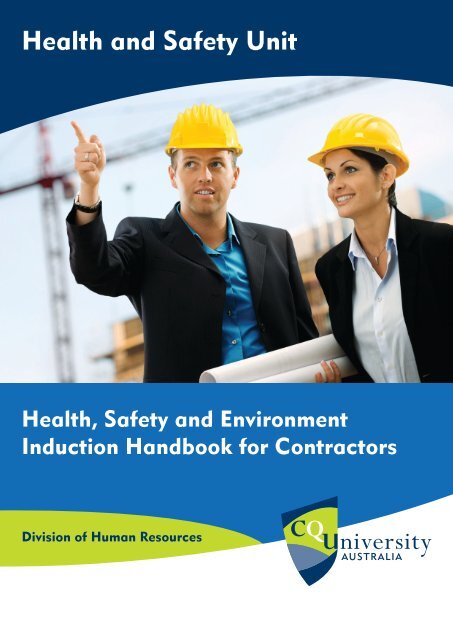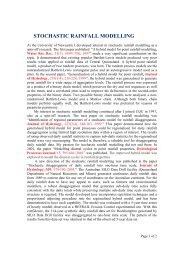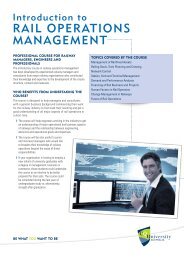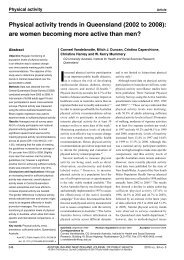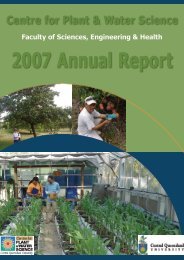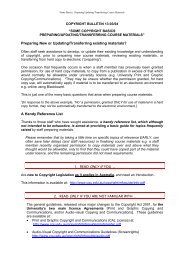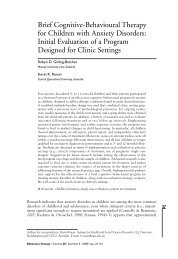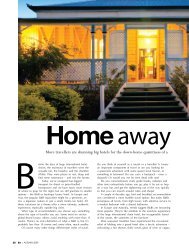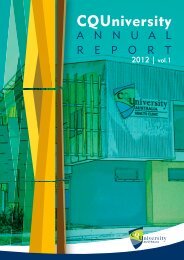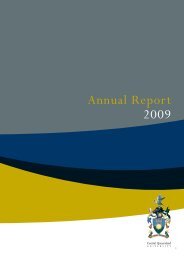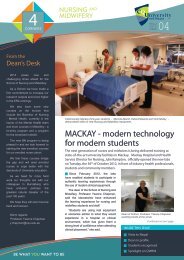Health, Safety and Environment Induction Handbook for Contractors
Health, Safety and Environment Induction Handbook for Contractors
Health, Safety and Environment Induction Handbook for Contractors
Create successful ePaper yourself
Turn your PDF publications into a flip-book with our unique Google optimized e-Paper software.
<strong>Health</strong> <strong>and</strong> <strong>Safety</strong> Unit<br />
<strong>Health</strong>, <strong>Safety</strong> <strong>and</strong> <strong>Environment</strong><br />
<strong>Induction</strong> H<strong>and</strong>book <strong>for</strong> <strong>Contractors</strong><br />
Division of Human Resources
Table of Contents<br />
1 Introduction ............................................................................................................................................. 1<br />
2 Disclaimer................................................................................................................................................ 2<br />
3 Acknowledgements ................................................................................................................................. 2<br />
4 <strong>Health</strong> <strong>and</strong> <strong>Safety</strong> Policy Statement ....................................................................................................... 3<br />
5 Reporting Line – Issue Resolution with Contractor ................................................................................ 4<br />
6 Basic Responsibilities ............................................................................................................................. 5<br />
7 <strong>Safety</strong> Breaches ...................................................................................................................................... 5<br />
8 Preparing to Work on University Grounds .............................................................................................. 6<br />
9 Vehicle Use ............................................................................................................................................. 7<br />
10 Injuries, Illnesses, Incidents <strong>and</strong> Dangerous Events .............................................................................. 7<br />
11 Behaviour on Site .................................................................................................................................... 7<br />
12 Alcohol <strong>and</strong> Other Drugs ......................................................................................................................... 8<br />
13 First Aid ................................................................................................................................................... 8<br />
14 Smoking .................................................................................................................................................. 8<br />
15 Hazardous Areas You May Come Across .............................................................................................. 8<br />
16 Personal Protective Equipment .............................................................................................................. 9<br />
17 Isolation of Fire Alarms ........................................................................................................................... 9<br />
18 Barricades <strong>and</strong> Fencing ........................................................................................................................ 10<br />
19 <strong>Safety</strong> Signs .......................................................................................................................................... 10<br />
20 Working at Heights ................................................................................................................................ 11<br />
21 Equipment, Plant <strong>and</strong> Tools .................................................................................................................. 11<br />
22 Trenching <strong>and</strong> Excavation .................................................................................................................... 13<br />
23 Asbestos................................................................................................................................................ 13<br />
24 Cabling <strong>and</strong> Services ............................................................................................................................ 14<br />
25 Confined Spaces ................................................................................................................................... 14<br />
26 Housekeeping ....................................................................................................................................... 14<br />
27 Plant Isolation ........................................................................................................................................ 15<br />
28 Interruption of Services ......................................................................................................................... 15<br />
29 Hot Work ............................................................................................................................................... 15<br />
30 Fire Extinguishers ................................................................................................................................. 16<br />
31 Emergency Procedures ........................................................................................................................ 16<br />
32 Our <strong>Environment</strong> ................................................................................................................................... 18<br />
33 Waste Management .............................................................................................................................. 19<br />
34 Hazardous Substances ......................................................................................................................... 19<br />
35 Protection of Bush l<strong>and</strong> <strong>and</strong> L<strong>and</strong>scaped Areas .................................................................................. 20<br />
36 Noise Pollution ...................................................................................................................................... 20<br />
37 Erosion <strong>and</strong> Sediment Control .............................................................................................................. 20<br />
38 Air Pollution ........................................................................................................................................... 20<br />
39 Water Pollution ...................................................................................................................................... 21<br />
40 Work Method Statements ..................................................................................................................... 21
1 Introduction<br />
Welcome to CQUniversity<br />
CQUniversity was established as the Queensl<strong>and</strong> Institute of Technology (Capricornia) in 1967, <strong>and</strong><br />
became the Capricornia Institute of Advanced Education in 1971 be<strong>for</strong>e a transition phase as the<br />
University College of Central Queensl<strong>and</strong> in 1990.<br />
CQUniversity achieved University status in January 1992 as the name University of Central Queensl<strong>and</strong>,<br />
subsequently preferring the present name - Central Queensl<strong>and</strong> University - which emphasises the<br />
University's unique partnership with the Central Queensl<strong>and</strong> region.<br />
CQUniversity was officially proclaimed by Act of Parliament in 1991 during a session of the Queensl<strong>and</strong><br />
Parliament <strong>and</strong> the new name <strong>and</strong> corporate identity were officially launched on May 20, 1994.<br />
CQUniversity has a number of campuses of different character that provide facilities <strong>for</strong> work, recreation,<br />
learning <strong>and</strong> research.<br />
CQUniversity is committed to providing a safe <strong>and</strong> healthy working environment <strong>for</strong> all employees,<br />
students, other members of the public <strong>and</strong> all contractors. It is our policy that all activities on University<br />
grounds are carried out safely <strong>and</strong> in full compliance with relevant laws.<br />
Unsafe work practices can result in serious injury <strong>and</strong> damage to property. They can also result in criminal<br />
charges <strong>and</strong> large financial penalties <strong>for</strong> employers <strong>and</strong> contractors alike. As a result it is CQUniversity<br />
policy that contractors underst<strong>and</strong> <strong>and</strong> acknowledge the <strong>Health</strong>, <strong>Safety</strong> & <strong>Environment</strong> <strong>Contractors</strong><br />
<strong>Induction</strong> H<strong>and</strong>book <strong>and</strong> it is a condition of <strong>Contractors</strong> <strong>and</strong> Sub-Contractor’s entry to all campuses.<br />
The groups within CQUniversity responsible <strong>for</strong> the University’s buildings infrastructure works are:<br />
• The Division of Facilities Management (DFM) is responsible <strong>for</strong> major <strong>and</strong> minor building <strong>and</strong><br />
infrastructure projects, refurbishment, external works, security, <strong>and</strong> building & grounds<br />
maintenance.<br />
• The In<strong>for</strong>mation Technology Division (ITD) is responsible <strong>for</strong> the provision of computing <strong>and</strong><br />
communication infrastructure.<br />
On behalf of each group enters into work contracts with <strong>Contractors</strong>. An officer (Project Officer) from<br />
the group responsible will be nominated as CQUniversity agent or representative <strong>for</strong> the contract<br />
administration of a project, <strong>and</strong> to monitor the safety of work sites.<br />
For the purposes of this H<strong>and</strong>book, CQUniversity agent or representative is referred to as:<br />
Project Officer: Is the CQUniversity Officer from the group responsible <strong>for</strong> the contract administration of<br />
a project or maintenance activity.<br />
Project Supervisor: Is the supervisor of the CQUniversity Officer from the group responsible <strong>for</strong> the<br />
contract administration of a project or maintenance activity.<br />
Project Manager: Is the Manager of the organisational unit of the CQUniversity Supervisor <strong>and</strong><br />
CQUniversity Officer.<br />
Workplace <strong>Health</strong> & <strong>Safety</strong> Officer: Is the appointed Workplace <strong>Health</strong> & <strong>Safety</strong> Officer of the group<br />
responsible <strong>for</strong> the work contract.<br />
Heath <strong>Safety</strong> <strong>and</strong> Unit: Overseas all CQUniversity <strong>Health</strong> & <strong>Safety</strong> Non- Compliance issues.<br />
working doc - contractor h<strong>and</strong>book v3 17082009 final.docx Updated August 2009 Page 1
2 Disclaimer<br />
The University has prepared this h<strong>and</strong>book in order to assist <strong>Contractors</strong> <strong>and</strong> their staff to work safely on<br />
University grounds <strong>and</strong> abide by the University requirements relating to people, property <strong>and</strong> the<br />
environment.<br />
The aim of the h<strong>and</strong>book is to explain the local site rules <strong>and</strong> some of the safety obligations of <strong>Contractors</strong><br />
<strong>and</strong> their employees working at the University.<br />
The Contractor has full responsibility to:<br />
• identify all relevant regulations dealing with safety;<br />
• underst<strong>and</strong> the full extent of the University <strong>and</strong> the <strong>Contractors</strong> respective legal obligations; <strong>and</strong><br />
• implement all measures necessary to protect <strong>and</strong> promote the safety of all persons working on or near<br />
the site on which the Contractor is working.<br />
Nothing in this h<strong>and</strong>book may be construed as implying or suggesting that the contractor is in anyway<br />
released or absolved from fully complying with all its statutory obligations of common law by virtue of<br />
CQUniversity having provided this h<strong>and</strong>book to the Contractor.<br />
3 Acknowledgements<br />
CQUniversity gratefully acknowledges the contribution of the University of Newcastle (Physical Planning<br />
& Estates Branch), University of Technology Sydney, <strong>and</strong> the University of Queensl<strong>and</strong>. Their permission<br />
to adapt the in<strong>for</strong>mation contained in their h<strong>and</strong>books has greatly simplified the task of producing this<br />
document.<br />
working doc - contractor h<strong>and</strong>book v3 17082009 final.docx Updated August 2009 Page 2
4 <strong>Health</strong> <strong>and</strong> <strong>Safety</strong> Policy Statement<br />
Policy Statement<br />
CQUniversity is committed to achieve the optimum attainable level of workplace health <strong>and</strong> safety <strong>for</strong> all<br />
staff, students, contractors <strong>and</strong> visitors throughout all of the University workplaces <strong>and</strong> workplace<br />
activities.<br />
This will be achieved through a process of continuous improvement to fully integrate <strong>Health</strong> <strong>and</strong> <strong>Safety</strong><br />
into all facets of the University’s business <strong>and</strong> activities.<br />
Scope<br />
This policy relates to all CQUniversity staff, students, contractors <strong>and</strong> visitors who participate in<br />
University business operations <strong>and</strong> activities.<br />
Policy Content<br />
This will be achieved through<br />
• ensuring compliance with all relevant legislative requirements.<br />
• provision of leadership to foster an organisation wide safety culture<br />
• ensuring management, staff, students, contractors <strong>and</strong> visitors are aware of their obligations <strong>and</strong><br />
demonstrate commitment to a safe <strong>and</strong> healthy environment<br />
• effective consultation, communication <strong>and</strong> supervision <strong>for</strong> all staff students, contractors <strong>and</strong> visitors<br />
enabling them to work <strong>and</strong> study in a safe <strong>and</strong> healthy environment<br />
• ensure risk management principles are an integral part of all business operations <strong>and</strong> activities.<br />
• implementation <strong>and</strong> maintenance of safe systems of work<br />
All staff, students, contractors <strong>and</strong> visitors are requested to comply with this policy <strong>and</strong> participate in the<br />
achievement of a safe <strong>and</strong> healthy work environment. Ongoing support of the University’s <strong>Health</strong> <strong>and</strong><br />
<strong>Safety</strong> Policy is the responsibility of everyone.<br />
working doc - contractor h<strong>and</strong>book v3 17082009 final.docx Updated August 2009 Page 3
5 Reporting Line – Issue Resolution with Contractor<br />
Issue identified on-site. Identifier<br />
makes a note in diary about issue.<br />
DEFINITIONS:<br />
PO – CQUniversity Project Officer<br />
CS – CQUniversity Supervisor<br />
CPM – CQUniversity Project Manager<br />
WHSO – Workplace <strong>Health</strong> & <strong>Safety</strong> Officer<br />
H&SU – <strong>Health</strong> & <strong>Safety</strong> Unit<br />
UH&SC – CQUniversity <strong>Health</strong> & <strong>Safety</strong> Committee<br />
NO<br />
Is activity life threatening?<br />
YES<br />
Identifier contact PO.<br />
Advise contractor to stop activity.<br />
Contact PO & WHSO, who will contact<br />
the contractor to resolve/report issue.<br />
PO diarises issue <strong>and</strong> uses own<br />
authority to resolve issue. Contact<br />
WHSO & CS <strong>for</strong> advice as required.<br />
NO<br />
Is issue resolved?<br />
YES<br />
CS & WHSO contact CM <strong>and</strong><br />
attempt to resolve issue with<br />
contractor.<br />
Is issue resolved?<br />
YES<br />
PO/WHSO completes appropriate<br />
paperwork & monitors contractor’s<br />
per<strong>for</strong>mance.<br />
NO<br />
CM:<br />
Reports issue to relevant authorities.<br />
Completes & files appropriate<br />
paperwork. In<strong>for</strong>ms H&SU, &<br />
UH&SC of non-compliance.<br />
Documents filed<br />
Contractor Evaluation System<br />
working doc - contractor h<strong>and</strong>book v3 17082009 final.docx Updated August 2009 Page 4
6 Basic Responsibilities<br />
Everyone working on University grounds is obliged to take reasonable care to:<br />
• ensure their own health <strong>and</strong> safety;<br />
• avoid risking the health <strong>and</strong> safety of any other person;<br />
• assist new site personnel in recognising job hazards, <strong>and</strong> following necessary safety procedures;<br />
• use personal protective equipment as trained <strong>and</strong> supplied;<br />
• ensure your staff <strong>and</strong> subcontractors are trained <strong>and</strong> technically, professionally or legally competent<br />
to do the work;<br />
• ensure their work site is safe <strong>for</strong> themselves <strong>and</strong> others;<br />
• practice good site housekeeping to minimise risk of avoidable accidents;<br />
• contract the CQUniversity Project Officer be<strong>for</strong>e starting any work;<br />
• keep fully in<strong>for</strong>med of any activities which could or may potentially pose a safety threat, hazard or<br />
danger to the safety or wellbeing of any person;<br />
• immediately take effective action to eliminate any safety hazard of which they may become aware ;( if<br />
unable to safely eliminate a safety hazard) advise the CQUniversity Project Officer. After hours<br />
contact Security.<br />
7 <strong>Safety</strong> Breaches<br />
CQUniversity treats instances of safety breaches very seriously.<br />
Should any CQUniversity employee observe any Contractor, or their employees, acting in an unsafe<br />
manner the CQUniversity Project Officer will be advised, the incident recorded <strong>and</strong> the Contractor<br />
notified <strong>and</strong> instructed to take immediate corrective action.<br />
The following applies:<br />
• if repeat safety breaches by the Contractor are observed; or<br />
• if CQUniversity considers that the Contractor is generally undertaking any part of the project in an<br />
unsafe manner; or<br />
• if the Contractor disregards any instruction to take prompt action to cease any unsafe work practices<br />
or fails to eliminate any safety hazard.<br />
This will be viewed by CQUniversity as a fundamental breach of the Contractor’s obligations.<br />
Specific examples of safety breaches include (but are not limited to):<br />
• failure to wear personal protective equipment;<br />
• working under the influence of alcohol or drugs;<br />
• incorrect management <strong>and</strong> use of hazardous materials;<br />
• inappropriate use of machinery or tools;<br />
• inappropriate or inadequate barricades, hoarding or fencing to protect persons on the work site or<br />
passing by.<br />
Where there is repeated failure or non-compliance, the contractor may be instructed to leave the site<br />
until the issues are resolved.<br />
working doc - contractor h<strong>and</strong>book v3 17082009 final.docx Updated August 2009 Page 5
8 Preparing to Work on University Grounds<br />
Registration of <strong>Contractors</strong><br />
All building & related trades’ contractors companies must be registered with the University.<br />
CQUniversity <strong>Contractors</strong> In<strong>for</strong>mation Sheet is to be completed by each individual contractor. The<br />
registration process requires a contractor to provide specific in<strong>for</strong>mation about certification. All<br />
construction contractors <strong>and</strong> their workers must have completed:<br />
• a General Contraction Industry Workplace <strong>Health</strong> <strong>and</strong> <strong>Safety</strong> <strong>Induction</strong> Course (Blue Card) with a<br />
Queensl<strong>and</strong> Accredited Training Provider;<br />
• attended a CQUniversity designed <strong>Health</strong> <strong>Safety</strong> <strong>and</strong> <strong>Environment</strong>al Contractor <strong>Induction</strong> session<br />
either by face to face or online.<br />
When a Contractor arrives on University grounds to carry out work they are required to report to the<br />
CQUniversity Project Officer responsible <strong>for</strong> the project <strong>and</strong> obtain authorisation to proceed unless other<br />
arrangements have been made with the CQUniversity Project Officer.<br />
<strong>Contractors</strong> must notify the CQUniversity Project Officer of their presence on the site. Out of hours<br />
please notify Security: Ph 0418 792982.<br />
Be<strong>for</strong>e the Job starts<br />
For all projects or work, pre-job start meeting <strong>and</strong> or discussion will be required between the Contractor<br />
<strong>and</strong> CQUniversity Project Officer. Pending on the scope of works the following may need to be<br />
considered:<br />
• the scope of the project or work;<br />
• safety hazards or risks associated with the work or project;<br />
• how the work will be per<strong>for</strong>med;<br />
• arrangements <strong>for</strong> isolation of services;<br />
• other specific safety controls <strong>for</strong> the particular job e.g. suitable time;<br />
• the need <strong>for</strong> work method statement; <strong>and</strong><br />
• the requirement of Work Permits <strong>for</strong> very high risk jobs.<br />
Work Permits<br />
Work permits are required <strong>for</strong> the following activities:<br />
• working with Asbestos Containing Materials;<br />
• Confined Space Entry;<br />
• Hot works;<br />
• Excavation/Trenching/Breaking ground;<br />
.<br />
Signing in<br />
<strong>Contractors</strong> will sign in at the respected designated area <strong>and</strong> complete the register, ‘Authorised<br />
<strong>Contractors</strong> Pass’ to work on site. <strong>Contractors</strong> will then be issued with an identification badge,<br />
‘Approved Contractor’; this badge must be worn in a visible place at all times whilst working on site.<br />
At the end of the day or work period, each contractor must sign off the site <strong>and</strong> return their identification<br />
badge.<br />
working doc - contractor h<strong>and</strong>book v3 17082009 final.docx Updated August 2009 Page 6
Keys<br />
<strong>Contractors</strong>’ issued with University keys are responsible <strong>for</strong> their safe keeping. All keys issued must be<br />
returned to the point of issues each day. Loss of keys must be reported to the CQUniversity Office<br />
immediately to maintain security. <strong>Contractors</strong> are liable <strong>for</strong> the costs associated with rekeying as a result<br />
of lost keys.<br />
9 Vehicle Use<br />
Parking space is available at each campus. Service vehicle bays are provided <strong>for</strong> the use of all service <strong>and</strong><br />
maintenance vehicles providing close access to the work site. Short term pick up <strong>and</strong> drop off parks are<br />
also provided to operators making a delivery or pick-up e.g. Australia Post.<br />
Parking or driving across footpaths <strong>and</strong> grassed l<strong>and</strong>scaped areas is prohibited.<br />
In instances where the nature of the work makes it essential to locate a vehicle on l<strong>and</strong>scaped areas, the<br />
Project Officer will advise of the least damaging pathway <strong>and</strong> parking location.<br />
All CQUniversity road signage will be followed as well as normal traffic roads rules.<br />
10 Injuries, Illnesses, Incidents <strong>and</strong> Dangerous Events<br />
Report all injuries, illnesses, incidents <strong>and</strong> dangerous events involving health, safety <strong>and</strong> environment<br />
issues, no matter how small, to the CQUniversity Project Officer using the reporting <strong>for</strong>m. The<br />
CQUniversity Incident Form is to be completed if any incident involves a contractor, student, staff<br />
member or visitor, as soon as possible <strong>and</strong> be<strong>for</strong>e the end of the working day.<br />
11 Behaviour on Site<br />
During any construction or maintenance work on site all University staff, contractors <strong>and</strong> their staff, are<br />
to ensure the least amount of disruption as possible to students, staff <strong>and</strong> visitors to the University.<br />
Offensive behaviour by any party will not be tolerated at the University. Offensive behaviour includes:<br />
• all behaviour <strong>and</strong> language that rein<strong>for</strong>ces inappropriate, demeaning or discriminatory attitudes or<br />
assumptions about persons based on age, race, sex, disability, sexual orientation, transgender status,<br />
or marital status; <strong>and</strong><br />
• behaviour such as whistling, unsolicited remarks of a sexual nature <strong>and</strong> swearing.<br />
Noise near buildings should be kept as low as possible <strong>and</strong> loud radios <strong>and</strong> other music are not permitted.<br />
Dogs are not to be brought onto University grounds. Dogs accompanying people with disabilities are the<br />
only exception.<br />
working doc - contractor h<strong>and</strong>book v3 17082009 final.docx Updated August 2009 Page 7
12 Alcohol <strong>and</strong> Other Drugs<br />
Persons affected by alcohol, other drugs or medication which impairs function are not permitted to carry<br />
out work on University campuses or properties.<br />
Where it is observed that a Contractor’s staff may be affected by alcohol or other drugs, the matter will<br />
be referred to the Contractor who will be required to take immediate action.<br />
The incident will be noted by the CQUniversity Project Officer. Should the situation continue or reoccur<br />
the Contractor will be requested to leave the site.<br />
13 First Aid<br />
<strong>Contractors</strong> are responsible <strong>for</strong> the first aid needs of their staff.<br />
Should emergency treatment be needed, an ambulance should be called on the emergency national<br />
number 000. Remember to dial 0 <strong>for</strong> an external line from an internal phone.<br />
Security is also to be notified to assist in directing ambulances. Phone Security on 0418 792982.<br />
14 Smoking<br />
The University no-smoking policy prohibits smoking inside University buildings, vehicles, within four (4)<br />
metres of any air-intake <strong>and</strong> within covered walkways <strong>and</strong> designated areas.<br />
15 Hazardous Areas You May Come Across<br />
Due to the variety <strong>and</strong> nature of activities carried out at the University <strong>for</strong> teaching, research <strong>and</strong><br />
development, you may come across areas which are unique when compared to the average workplace<br />
where you carry out contracting work. In many cases these areas can be hazardous if the correct controls<br />
are not followed. You should not enter, <strong>and</strong> will need to undergo specific induction procedures be<strong>for</strong>e<br />
carrying out work in, the following locations:<br />
Animal Houses<br />
Due to potential allergies, bites, scratches, kicks or infections associated with zoonotic diseases, specific<br />
procedures are required prior to entry. Please contact the CQUniversity Project Officer to arrange a<br />
specific induction <strong>for</strong> each laboratory you are required to enter.<br />
Physical Containment - PC1/PC2 <strong>and</strong> other Laboratories<br />
There are a variety of laboratories at the University including chemical <strong>and</strong> biological laboratories where<br />
pathogens, carcinogens, lasers or/<strong>and</strong> radioactive material are used.<br />
Do not enter a laboratory to carry out work or <strong>for</strong> any other reason without having been given a specific<br />
induction <strong>for</strong> the laboratory concerned. All laboratories do not have the same procedures. You must ask<br />
the CQUniversity Project Officer to arrange a specific induction <strong>for</strong> each laboratory you are required to<br />
enter.<br />
working doc - contractor h<strong>and</strong>book v3 17082009 final.docx Updated August 2009 Page 8
Chemical Store<br />
There are various chemical depots at the University. No repairs or construction work is to be undertaken<br />
in a depot unless the risk to a person's health or safety has been assessed <strong>and</strong> where required, all hazardous<br />
substances or dangerous goods have been removed <strong>and</strong> cleaned from the depot. Consult the<br />
CQUniversity Project Officer be<strong>for</strong>e working in or around a chemical depot.<br />
High Voltage Substations<br />
Access to high voltage substations at the University is to be arranged through the CQUniversity Project<br />
Officer. Only appropriately licensed <strong>and</strong> trained persons will be granted access to high voltage<br />
substations.<br />
Broken Pit Lids<br />
Broken or damaged pit lids have been identified as a potentially serious health <strong>and</strong> safety risk. Pit lids are<br />
the access covers <strong>for</strong> electrical, communications, water, irrigation <strong>and</strong> sewerage pits <strong>and</strong> also storm water<br />
grates. If, during the course of doing work at any University campus, staff or contractors damage a pit lid<br />
or notice a damaged pit lid they should report it immediately to the relevant CQUniversity Projects<br />
Officer or out of hours to Security.<br />
Isolation of Fume Cupboards<br />
Fume cupboard or chemical store ventilation can only be isolated by arrangement with the CQUniversity<br />
Project Officer. Fume extraction fans shall not be isolated be<strong>for</strong>e ‘tagging out’ all affected laboratory<br />
fume hoods to prevent their use (refer to section on Plant Isolation). <strong>Contractors</strong> shall personally confirm<br />
that laboratory staff are aware that they are about to start work on a fume hood system <strong>and</strong> when the job<br />
has been completed.<br />
16 Personal Protective Equipment<br />
<strong>Contractors</strong> shall supply their employees with all appropriate personal protective equipment <strong>and</strong> shall<br />
ensure that their employees use it correctly (e.g. hard hats, safety boots, gloves, safety glasses <strong>and</strong><br />
clothing), as required by applicable legislation, codes of practice <strong>and</strong> safe work practices.<br />
17 Isolation of Fire Alarms<br />
Many areas of the University are covered by automatic fire detection & alarm systems linked to the<br />
Queensl<strong>and</strong> Fire <strong>and</strong> Rescue Service. If works involve dust, vibration, moisture, aerosol sprays, fumes,<br />
or mechanical damage to detection equipment, contractors shall ensure that fire alarms are temporarily<br />
isolated. The Contractor shall advise the CQUniversity Project Officer who will arrange the temporary<br />
isolation with Security. The Contractor shall be responsible <strong>for</strong> all costs involved with the temporary<br />
isolation of fire alarms, <strong>and</strong> shall ensure that appropriate safety arrangements are in place <strong>for</strong> the duration<br />
of the isolation of any alarm.<br />
If, during the course of the works, the automatic alarm is triggered the Queensl<strong>and</strong> Fire <strong>and</strong> Rescue<br />
Service shall attend the building. Should any triggering be caused by the Contractor or any of his<br />
subcontractors, the Contractor shall bear the cost of any charges levied by the Queensl<strong>and</strong> Fire <strong>and</strong><br />
Rescue Service.<br />
working doc - contractor h<strong>and</strong>book v3 17082009 final.docx Updated August 2009 Page 9
18 Barricades <strong>and</strong> Fencing<br />
To ensure the safety of all persons on the work-site, or passing by, <strong>Contractors</strong> must supply <strong>and</strong> erect any<br />
necessary barricades <strong>and</strong> fencing appropriate to the work they are doing.<br />
All materials, equipment, plant <strong>and</strong> tools must also be safely stored within barricades <strong>and</strong> fencing as<br />
required.<br />
Particular care must be taken to check <strong>and</strong> secure the barricades <strong>and</strong> fences whenever contract staff leave<br />
the work area. This may include providing temporary lighting on the site, if deemed necessary by the<br />
Contractor or directed by the CQUniversity Project Officer.<br />
Pedestrian access must not be impeded without prior approval of the CQUniversity Project Officer.<br />
Emergency Exit paths must be maintained free of all obstructions. An exit must not be blocked at the<br />
point of discharge.<br />
19 <strong>Safety</strong> Signs<br />
<strong>Safety</strong> signs are placed on the University campus to protect your health <strong>and</strong> safety. <strong>Safety</strong> signs of different<br />
colours <strong>and</strong> shapes mean different things. A red circle with a line through it means this is something you<br />
must not do. All CQUniversity laboratories <strong>and</strong> workshops display a hazard in<strong>for</strong>mation sign which<br />
indicates the types of hazards present <strong>and</strong> the required safety precautions.<br />
A yellow triangle warns you of a danger, or risk to your health.<br />
A blue circle tells you that you must wear some special safety equipment.<br />
working doc - contractor h<strong>and</strong>book v3 17082009 final.docx Updated August 2009 Page 10
20 Working at Heights<br />
Ladder & Harness Use<br />
No domestic-type ladders are to be used on University grounds. Industrial ladders must comply with the<br />
Australian St<strong>and</strong>ard AS 1892 <strong>and</strong> must be regularly inspected <strong>and</strong> maintained.<br />
The tops of ladders must be secured when in use. When working at heights (where no other protection is<br />
available) a full parachute safety harness, con<strong>for</strong>ming to Australian St<strong>and</strong>ards, must be worn <strong>and</strong> secured<br />
to approve fixing devices. Refer to section on Work Method Statements.<br />
Scaffolds & Plat<strong>for</strong>ms<br />
All scaffolding <strong>and</strong> working plat<strong>for</strong>ms (suspended or not) must con<strong>for</strong>m to statutory <strong>and</strong> Australian<br />
St<strong>and</strong>ard requirements, <strong>and</strong> be erected by an individual with an appropriate certificate of competency.<br />
21 Equipment, Plant <strong>and</strong> Tools<br />
Electrical<br />
Work on or near live electrical circuits or live distribution boards is prohibited.<br />
Unless double insulated, all equipment <strong>and</strong> appliances that are plugged or direct-wired are to be<br />
connected to an approved Earth Leakage Circuit Breaker (ELCB).<br />
Electrical leads must be supported clear of floors or under protective covers, <strong>and</strong> connected to the nearest<br />
power outlet.<br />
Electrical leads must be removed from the power outlet when not in use. All leads <strong>and</strong> power tools must<br />
be tested <strong>and</strong> tagged in accordance with statutory requirements.<br />
• leads passing through doorways must be protected;<br />
• piggyback leads <strong>and</strong> double adaptors are not to be used.<br />
Machine Guarding<br />
All h<strong>and</strong> tools, machinery or other equipment must be operated with effective guards.<br />
H<strong>and</strong> Tools<br />
Picks, shovels, axes, crowbars, hammers, wrenches, files, screwdrivers, etc. must be checked regularly.<br />
The tool must not be used if damaged or in the event of any known defects. Proper repair or<br />
replacement is the only alternative.<br />
Use an approved wrist-stop or lanyard to secure the tool if there is a risk of it falling <strong>and</strong> injuring people<br />
below.<br />
working doc - contractor h<strong>and</strong>book v3 17082009 final.docx Updated August 2009 Page 11
Lasers<br />
Lasers may only be used by persons who have completed a recognised course. Lasers must be used with<br />
the following precautions:<br />
• up to class 3A only to be used on the construction site;<br />
• positioned so as not to be at eye height of employees in the area;<br />
• warning signs to be erected.<br />
Explosive Power Tools<br />
The use of explosive power tools is not permitted however the use of “impact drivers” is permitted.<br />
Mobile Mechanical Plant<br />
All mobile plant such as front-end loaders, dozers, backhoes, <strong>for</strong>klifts etc, must be maintained in a<br />
condition that ensures it is safe to use. When not in use, mobile plant must have keys removed, blades <strong>and</strong><br />
buckets lowered onto the ground <strong>and</strong> must be chocked/ blocked.<br />
Compressed Air Equipment<br />
This section includes scabblers, water/ air jets, impact wrenches, grinding tools etc.<br />
Always use care when working with compressed air. If compressed air enters the blood stream through a<br />
break in the skin it can be fatal.<br />
Wear:<br />
• suitable eye protection to guard against airborne substances;<br />
• ear protection where excessive noise is likely to occur;<br />
• respiratory protection where dust is present ; <strong>and</strong><br />
• under no circumstances should a jet of air be directed towards the body of another person.<br />
Electric Welding<br />
Permits <strong>for</strong> Hot Work must be obtained from the CQUniversity Project Officer, refer to section on Hot<br />
Work.<br />
Aprons, leather sleeves, gauntlet gloves, eye protection, welding spats (or flame-proof overalls) must be<br />
worn by welders <strong>and</strong> assistants where there is danger of injury from hot material.<br />
Insulated footwear shall be worn by welders when working in damp places as the danger of electric shock<br />
exists.<br />
Any person assisting a welder must be competent <strong>and</strong> experienced in that area of work.<br />
Where the job is to be per<strong>for</strong>med at ground level, welding screens must be used to prevent sparks from<br />
flying into adjacent areas <strong>and</strong> to screen nearby workers from welding flash.<br />
All electrical welding cables must be inspected weekly <strong>and</strong> maintained in good condition. There must be<br />
no bare wires <strong>and</strong> connections shall be solidly made so that no sparking or hot spots will occur.<br />
working doc - contractor h<strong>and</strong>book v3 17082009 final.docx Updated August 2009 Page 12
22 Trenching <strong>and</strong> Excavation/Breaking Ground<br />
All excavation must be adequately shored <strong>and</strong> safe access must be provided in all excavations.<br />
All trenches over 1.5m in depth must be protected against collapse, <strong>and</strong> h<strong>and</strong>rails or barricades erected<br />
around the trench <strong>and</strong> in place at all times to comply with statutory requirements.<br />
The Contractor must:<br />
• complete a Work Method Statement;<br />
• seek a permit from the CQUniversity Project Officer be<strong>for</strong>e commencing trenching or excavation;<br />
• obtain a drawing of the services located in the area;<br />
• ensure that the services per<strong>for</strong>med are inspected by the CQUniversity Contracts Supervisor be<strong>for</strong>e<br />
backfilling;<br />
• mark up <strong>and</strong> return the drawing with the changes made (particularly to services) to indicate the ‘as<br />
built’ details after completion.<br />
23 Asbestos<br />
Like many buildings built be<strong>for</strong>e the early 1990s, a number of buildings at CQUniversity used asbestoscontaining<br />
materials at the time of construction. These products include floor tiles, asbestos cement<br />
piping <strong>and</strong> sheeting, pipe <strong>and</strong> boiler insulation, ceiling tiles, insulation around heater banks in air<br />
conditioning duct work, laboratory equipment such as autoclaves, old electrical switchboards etc.<br />
CQUniversity has developed an Asbestos Management Plan (AMP) to deal with the identification,<br />
management <strong>and</strong> removal of asbestos from all University sites. Staff <strong>and</strong> contractors must adhere to the<br />
Management Plan whenever dealing with asbestos.<br />
The Asbestos Management Plan contains:<br />
• scope <strong>and</strong> limitations of the AMP;<br />
• overview of the risk assessment process;<br />
• asbestos-related regulatory requirements;<br />
• CQUniversity responsibilities; principles of asbestos management;<br />
• description of the st<strong>and</strong>ard asbestos survey report/register utilised by the University <strong>and</strong> its<br />
application;<br />
• management of in-situ asbestos materials;<br />
• safe working practices;<br />
• requirements <strong>for</strong> asbestos removal;<br />
• emergency response procedures;<br />
• training <strong>and</strong><br />
• future initiatives.<br />
All contractors are to view the AMP prior to any works being carried out in areas where asbestos<br />
materials have been identified. A permit <strong>for</strong> works is to be obtained prior to the commencement of any<br />
works. A Work Method Statement is to be developed <strong>and</strong> presented to CQUniversity Project Officer<br />
be<strong>for</strong>e works is commenced.<br />
The Asbestos Management Plan is available from the Division of Facilities Management, phone (07)<br />
49309241 or from the <strong>Health</strong> <strong>and</strong> <strong>Safety</strong> Web Site.<br />
working doc - contractor h<strong>and</strong>book v3 17082009 final.docx Updated August 2009 Page 13
24 Cabling <strong>and</strong> Services<br />
There are numerous underground services throughout the University including electrical cables, pipes,<br />
gas <strong>and</strong> telecommunication services. Check <strong>for</strong> locations be<strong>for</strong>e you dig. The University has maps<br />
documenting service locations throughout University sites. The relevant CQUniversity Project Officer<br />
must be contacted prior to conducting any excavation or other work, which could potentially damage<br />
services <strong>and</strong> an Excavation, Trenching & Breaking Ground Permit obtained.<br />
25 Confined Spaces<br />
When working in confined spaces the provisions of the legislation are to be complied with by the<br />
Contractor <strong>and</strong> employees. A permit <strong>for</strong> Confined Space entry is to be obtained from the CQUniversity<br />
Project Officer.<br />
Where working in enclosed areas, care should be taken to ventilate the area well if petrol or diesel motor<br />
driven equipment is being used.<br />
The Contractor must ensure that fume evacuation, airflow <strong>and</strong> exchanges of air are all maintained as<br />
necessary. Confined space gas detection equipment must be used to test the environment.<br />
26 Housekeeping<br />
Rubbish<br />
Rubbish must be managed in accordance with <strong>Environment</strong>al Protection Act <strong>and</strong> Local Council By-laws.<br />
Under no circumstances are contractors to dump rubbish on vacant l<strong>and</strong> on the campus.<br />
The disposal <strong>and</strong> washing out of excess concrete from trucks is not permitted on site.<br />
Paint contractors shall not dispose of paints or clean painting equipment on University grounds.<br />
Site Tidiness<br />
The work-site <strong>and</strong> surrounding area should be kept clean <strong>and</strong> tidy <strong>and</strong> any safety or fire hazards removed<br />
promptly (e.g. oily rags, flammable materials <strong>and</strong> garbage).<br />
Keep in mind other safety actions such as replacing lids <strong>and</strong> caps on containers, wiping up spills, removing<br />
or bending over nails or bolts <strong>and</strong> removing other dangerous protruding objects progressively.<br />
working doc - contractor h<strong>and</strong>book v3 17082009 final.docx Updated August 2009 Page 14
27 Plant Isolation<br />
The University has implemented a Plant Isolation, <strong>Safety</strong> Tag <strong>and</strong> Lockout Procedure. <strong>Contractors</strong> must<br />
ensure that they <strong>and</strong> their staff comply with this procedure.<br />
<strong>Contractors</strong> shall use CQUniversity ‘Danger’ <strong>and</strong> ‘Out of Service’ tags <strong>and</strong> use them as follows:<br />
For your own protection:<br />
• isolate all equipment, switches <strong>and</strong> controls required to ensure your work-site is safe;<br />
• place the tag(s) <strong>and</strong> locks on the appropriate electrical switches <strong>and</strong> switchboards, other appropriate<br />
switches, valves, main isolators or key rings.<br />
For the protection of others:<br />
• never remove someone else’s danger tag;<br />
• do not operate switches, valves or equipment that displays a ‘Danger’ tag or ‘Out of Service’ tag.<br />
If the equipment is still not safe at the end of the shift, the ‘Danger’ tag must be changed to an ‘Out of<br />
Service’ tag.<br />
28 Interruption of Services<br />
Where a Contractor’s work involves a requirement to isolate energy services (electricity, gas, telephone,<br />
communications, or water supply) to all or part of a building, 48 hours notice must be given to the<br />
CQUniversity Project Officer. The CQUniversity Project Officer will in<strong>for</strong>m appropriate University<br />
staff. Should services be shut-down accidentally the Contractor should immediately advise the<br />
CQUniversity Project Officer.<br />
29 Hot Work<br />
A Hot Work Permit must be obtained from the CQUniversity Project Officer prior to commencing any<br />
hot work such as welding, brazing or removal of paint by heat gun or burner.<br />
The Contractor must ensure that fire alarms are isolated. Refer to section on Isolation of Fire Alarms.<br />
Adequate fire protection must be present, with suitable fire extinguishers attached to, or near each<br />
welding plant. Welders must use screens to protect all personnel from welding flashes <strong>and</strong> any hot waste<br />
produced during the welding process. Workers undertaking the welding should wear the correct<br />
personal protective equipment.<br />
working doc - contractor h<strong>and</strong>book v3 17082009 final.docx Updated August 2009 Page 15
30 Fire Extinguishers<br />
In cases where the Contractor is required to provide fire extinguishers Australian St<strong>and</strong>ard AS1841, these<br />
must be regularly inspected <strong>and</strong> maintained in accordance with the Australian St<strong>and</strong>ard AS1851-1. Fire<br />
extinguishers <strong>and</strong> the associated hose reels can be located in most University buildings. They are<br />
identifiable by triangular sign-posting in the corridors.<br />
It is VERY IMPORTANT to use the right extinguisher in the correct situation.<br />
To allow <strong>for</strong> instant recognition of the most suitable extinguisher, identification discs are displayed on the<br />
can to indicate the particular types of fire it can be used on.<br />
<strong>Contractors</strong> must know how to use each type of fire extinguisher.<br />
Dry Chemical<br />
The dry chemical extinguisher is safe to use on flammable liquid <strong>and</strong> electrical<br />
equipment fires.<br />
Water<br />
Water extinguishers can be used on fires of combustible material such as wood, paper<br />
<strong>and</strong> fabrics. This type of extinguisher must not be used on electrical, combustible<br />
metals or flammable liquid fires.<br />
Foam<br />
Foam extinguishers are ideal <strong>for</strong> combustible materials <strong>and</strong> flammable liquid fires such<br />
as wood, paper, fabric, cooking fats <strong>and</strong> petrol. However, this type must not be used<br />
on combustible metal or electrical fires.<br />
Carbon Dioxide<br />
Carbon dioxide (CO2) is an ideal extinguisher <strong>for</strong> electrical <strong>and</strong> flammable liquid fires.<br />
It is also effective on small surface combustible material fires.<br />
Aqualoy<br />
Aqualoy is a purpose specific extinguisher <strong>for</strong> cooking appliance areas such as kitchen<br />
ranges, cooking oils <strong>and</strong> fats. Care should be taken with all electrical equipment.<br />
31 Emergency Procedures<br />
Emergency Services<br />
To contact the Queensl<strong>and</strong> Fire <strong>and</strong> Rescue Service, Police or Ambulance in an emergency:<br />
All HOURS DIAL 0-000 ON ANY INTERNAL PHONE<br />
Notify security of the nature of the emergency.<br />
All hazardous situations, incidents or damage to CQUniversity property must be reported to the<br />
CQUniversity Project Officer <strong>and</strong> the <strong>Health</strong> & <strong>Safety</strong> Unit.<br />
working doc - contractor h<strong>and</strong>book v3 17082009 final.docx Updated August 2009 Page 16
University Security Services<br />
University Security Services vary from campus to campus.<br />
They should be contacted to report any security problems, e.g. fire, damage or theft. Please consult with<br />
your CQUniversity Project Officer <strong>for</strong> the current contact numbers.<br />
In the Case of a Emergency<br />
Remove person in immediate danger;<br />
Alert nearby staff <strong>and</strong> members of the public - call 000 <strong>and</strong> alert CQUniversity Project Officer;<br />
Confine the fire <strong>and</strong> smoke, close windows <strong>and</strong> doors (if safe) keep low, under the smoke;<br />
Extinguish <strong>and</strong> control the fire (if safe to do so).<br />
Evacuation Procedures<br />
• follow all instructions given by members of the Emergency Control Organisation <strong>and</strong> or other<br />
Emergency Services;<br />
• leave immediately by the nearest safe exit;<br />
• move quickly, do not run;<br />
• if possible, close doors behind you;<br />
• report to your designated assembly area;<br />
• do not leave the assembly area until the Chief Warden gives the “all clear”;<br />
• if any injuries are sustained, notify a warden or first aid officer;<br />
• advise a Warden immediately if you’re aware of people trapped in the building.<br />
Assembly areas<br />
For capital works projects, as directed by the CQUniversity Project Officer, <strong>Contractors</strong> must nominate a<br />
suitable assembly area where their employees are to congregate in the case of a fire or other emergency.<br />
<strong>Contractors</strong> are responsible <strong>for</strong> advising employees of the locations of assembly areas, <strong>and</strong> <strong>for</strong> ensuring<br />
that head-counts are undertaken at these areas in an emergency situation.<br />
For non-capital works projects, <strong>Contractors</strong> are to assemble at the assembly areas as per each building<br />
Evacuation Management Plan.<br />
working doc - contractor h<strong>and</strong>book v3 17082009 final.docx Updated August 2009 Page 17
32 Our <strong>Environment</strong><br />
Your Basic Responsibilities<br />
CQUniversity accepts that every individual has a ‘duty of care’ to the environment.<br />
This means that employers <strong>and</strong> employees alike need to:<br />
• take all reasonable steps to prevent pollution <strong>and</strong> protect the environment;<br />
• show that everything that could have been done to prevent an incident from occurring, has been<br />
done;<br />
• ensure that all necessary pollution control measures are in place <strong>and</strong> are regularly checked <strong>and</strong><br />
maintained to minimise the risk of an environmental incident.<br />
Corporations <strong>and</strong> Individuals can be fined, or imprisoned, <strong>for</strong> seriously polluting the environment.<br />
Officers from Local Councils <strong>and</strong> the <strong>Environment</strong> Protection Authority (EPA) are authorised to issue<br />
infringement notices when pollution events are observed, or recorded by members of the public.<br />
It is in everybody’s interest to underst<strong>and</strong> <strong>and</strong> meet their environmental obligations.<br />
Reporting <strong>Environment</strong>al Problems<br />
You are required to call the CQUniversity Project Officer as soon as you become aware of any incident<br />
that may cause environmental harm (e.g. a chemical spill or leak).<br />
working doc - contractor h<strong>and</strong>book v3 17082009 final.docx Updated August 2009 Page 18
33 Waste Management<br />
The University strongly encourages <strong>Contractors</strong> to identify waste minimisation options at the start of each<br />
job. These include:<br />
• working out costs <strong>and</strong> savings involved in minimising waste;<br />
• taking care not to over-order;<br />
• ensuring that subcontractors are responsible <strong>for</strong> their waste;<br />
• utilising off-cuts;<br />
• recycling materials where practicable;<br />
• buying materials with minimal packaging;<br />
• require suppliers to accept their packaging back.<br />
There are many opportunities <strong>for</strong> waste to be reduced. No-one will be better than you <strong>and</strong> your team to<br />
find waste solutions. Whatever the waste, it is probable that someone in the community could use it. At<br />
most work sites an industrial rubbish skip is required, but only <strong>for</strong> materials that cannot be re-used or<br />
recycled. Skips must have a lid so that rubbish doesn’t blow away, <strong>and</strong> rainwater doesn’t collect in the<br />
bin. Other factors include:<br />
• do not dispose of waste on University property;<br />
• do not use ordinary University rubbish bins <strong>for</strong> construction <strong>and</strong> demolition wastes;<br />
• you are legally responsible to ensure your waste is disposed of in the correct manner;<br />
• hazardous waste treatment <strong>and</strong> disposal must comply with <strong>Environment</strong>al Protection Authority<br />
Regulations.<br />
34 Hazardous Substances<br />
The Contractor must submit a Material <strong>Safety</strong> Data Sheet (MSDS) <strong>for</strong> all substances <strong>and</strong> a risk assessment<br />
of all hazardous substances to the CQUniversity Project Officer <strong>for</strong> each substance that is to be brought<br />
onto University grounds, <strong>and</strong> maintain a copy at the work site.<br />
All hazardous substances brought onto University grounds must be clearly labelled according to the<br />
legislation. Be sure to follow h<strong>and</strong>ling <strong>and</strong> storage instructions that appear on labels.<br />
Chemicals must be contained in reliable, tightly sealed containers. Containers must be stored indoors on<br />
an impervious floor, with enough bonding to hold any spill.<br />
Clean-up materials must be provided in case of spillage. Liquid spills can be mopped up by rags, sawdust,<br />
or commercially available absorbent products.<br />
The Contractor must ensure that clean up materials are appropriate <strong>for</strong> the chemicals used, <strong>and</strong> that at<br />
least one person on the site at any time is trained to clean up a spill. This includes always ensuring an<br />
adequate stock of clean-up material is available <strong>and</strong> easily accessible.<br />
Hazardous waste treatment <strong>and</strong> disposal must comply with <strong>Environment</strong>al Protection Authority<br />
Regulations.<br />
working doc - contractor h<strong>and</strong>book v3 17082009 final.docx Updated August 2009 Page 19
35 Protection of Bush l<strong>and</strong> <strong>and</strong> L<strong>and</strong>scaped Areas<br />
All native flora <strong>and</strong> fauna is valued very highly, <strong>and</strong> <strong>Contractors</strong> are asked to respect the campus ecology<br />
when on the grounds.<br />
If any work is likely to disturb bush l<strong>and</strong>, l<strong>and</strong>scaping or grassed areas, the Contractor must advise the<br />
CQUniversity Project Officer a minimum of one week prior to the intended commencement of the work.<br />
Every ef<strong>for</strong>t must be made to avoid disturbing trees as well as l<strong>and</strong>scaped <strong>and</strong> grassed areas. Where<br />
negligent work results in damage to these areas, the cost of rectifying damage will be recovered from the<br />
Contractor.<br />
36 Noise Pollution<br />
The atmosphere at the University needs to remain conducive to learning <strong>and</strong> research at all times.<br />
37 Erosion <strong>and</strong> Sediment Control<br />
Erosion <strong>and</strong> sediment controls must be installed when it is possible that work on University grounds will<br />
cause erosion or sediment losses. Install erosion <strong>and</strong> sediment controls be<strong>for</strong>e work starts. Keep roads <strong>and</strong><br />
pathways free of mud <strong>and</strong> debris.<br />
38 Air Pollution<br />
Dust<br />
Dust can cause health problems <strong>for</strong> workers <strong>and</strong> others on the campus. If a work-site is generating dust:<br />
• cover materials <strong>and</strong> stockpiles that generate dust;<br />
• contain dust within the work areas;<br />
• place sweepings into a bag or box be<strong>for</strong>e putting them into a skip to prevent dust from becoming<br />
airborne when the bin is emptied.<br />
Solvents<br />
Many chemicals release polluting vapours when bottles are open.<br />
• always seal solvent containers with a tight lid;<br />
• use water-based or biodegradable strippers <strong>and</strong> cleaners wherever possible.<br />
Lighting of Fires<br />
Never light a fire on University grounds.<br />
Refrigerant Gases (CFCs)<br />
Refrigerant gases in air conditioners deplete the ozone layer if allowed to escape.<br />
• it is against the law to vent CFCs or HCFCs ;<br />
• CFCs <strong>and</strong> HCFCs must be recovered from air conditioning plant during servicing or<br />
decommissioning;<br />
working doc - contractor h<strong>and</strong>book v3 17082009 final.docx Updated August 2009 Page 20
39 Water Pollution<br />
It is against the law to place any material (other than clean water) in a position where it is likely to leak,<br />
fall or be blown into any drain or gutter that is used to receive rainwater.<br />
• keep the footpath <strong>and</strong> gutter around your work-site free of litter, soil <strong>and</strong> s<strong>and</strong>, particularly at the<br />
close of each working day;<br />
• don’t sweep litter, leaves or anything else into drains or gutters;<br />
• keep rubbish bins covered;<br />
• keep spill clean-up kit close by;<br />
• hosing rubbish, soil, s<strong>and</strong>, leaves (or anything else!) into the gutter, is not permitted;<br />
• disposing of cleaning fluids, paints <strong>and</strong> solvent in drains or gutters is not permitted.<br />
40 Work Method Statements<br />
CQUniversity requests that to ensure workplace health <strong>and</strong> safety is managed appropriately that all<br />
contractors will prepare <strong>and</strong> provide Work Method Statements where contractors are engaged in high risk<br />
construction activities. A copy of this plan is to be given to the CQUniversity Project Officer prior to<br />
starting work on the site. A permit to work is then issued by the CQUniversity Project Officer.<br />
A Work Method Statement is to be prepared <strong>for</strong> high risk construction activities which include:<br />
• entering a trench deeper than 1.5m;<br />
• using explosives;<br />
• entering confined spaces;<br />
• using hazardous materials;<br />
• where a person could fall at least 2m;<br />
• activity is per<strong>for</strong>med out on a roof with a pitch > 26 degrees;<br />
• contractor concludes that activity could result in death or bodily harm;<br />
• prescribed activity;<br />
• demolition work;<br />
• removal of asbestos-containing materials;<br />
• tilt up <strong>and</strong> precast concrete construction work;<br />
• structural alterations that require temporary support to prevent collapse;<br />
• the movement of powered mobile plant at the workplace;<br />
• work on a telecommunications tower;<br />
• work in, over or adjacent to water where there is a risk of drowning;<br />
• work on, or adjacent to water where there is a risk of drowning;<br />
• work on, or adjacent to, a road or railway;<br />
• work on or near a chemical or fuel or refrigerant line;<br />
• work near an exposed energised electrical installation;<br />
• work in an area that may have a contaminated or flammable atmosphere;<br />
• work in an area where there are artificial extremes of temperature.<br />
A work method statement <strong>for</strong> a high risk construction activity, other than a prescribed activity, may be a<br />
generic work method statement prepared <strong>for</strong> workplaces where the activity is to be per<strong>for</strong>med in the<br />
same way in the same or similar circumstances.<br />
working doc - contractor h<strong>and</strong>book v3 17082009 final.docx Updated August 2009 Page 21
Work Method Statements must include:<br />
• the nature of the high-risk activity;<br />
• the name of the contractor/s <strong>and</strong> ABN (if one available);<br />
• the specific proposed control measures;<br />
• how the activity will be per<strong>for</strong>med;<br />
• how the effectiveness of the control measures will be monitored <strong>and</strong> reviewed;<br />
• any prescribed occupation requirements.<br />
For demolition <strong>and</strong> asbestos material removal:<br />
• include prescribed activity certificate number, specific control measures, training <strong>and</strong> supervision<br />
arrangements.<br />
Low risk activities - A risk assessment will be conducted by contractors to determine the risk associated<br />
with the work/project. If it is determined that the risk is low, self-employed contractors are not required<br />
to submit a safety plan, however, they are required to abide to all relevant legislation <strong>and</strong> CQUniversity<br />
policies. These policies will be made available to the contractor on request.<br />
working doc - contractor h<strong>and</strong>book v3 17082009 final.docx Updated August 2009 Page 22
Developed by: <strong>Health</strong> <strong>and</strong> <strong>Safety</strong> Unit<br />
Division of Human Resources <strong>and</strong> Division of Facilities Management<br />
Revised August 2009, Version 3


